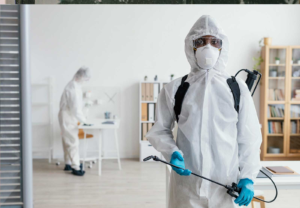Pest Control Sparta NJ manages pests to prevent them from harming desirable plants, crops, or other organisms. Preventive measures include removing food and water sources, closing off hiding places, and eliminating disease vectors.
Regular scouting and suppression can help reduce populations to below action thresholds. Then, natural enemies, such as the nematode Steinernema carpocapsae (pictured), can take over.

A pest is any organism that negatively impacts the availability, quality or value of a human resource, including crops, food, animals, property, gardens, homes and landscapes. A plant species can also be considered a pest if it disrupts the balance of nature by displaces or competes with native plants. Pests can be insects, fungi, bacteria, viruses, nematodes, rodents or weeds.
The most effective way to control a pest infestation is prevention. This can be achieved by removing food, water or shelter, reducing clutter and sealing off entry points that could be used to enter a building. This is especially important for commercial and hospitality operations where the potential for a pest invasion is high. Ensure that all food products are stored in sealed containers, dispose of garbage regularly and use rodent repellents for outdoor areas. Clutter can be a breeding ground for rodents, so keep stacks of newspapers and magazines away from the walls and make sure doors and windows are closed and screened.
Preventing pests is the best way to eliminate them, but this is not always possible. Some pests, such as fleas and cockroaches can be carried into buildings by employees on their clothing, so preventive measures must be integrated into the company’s culture. This includes ensuring that staff wear protective clothing when handling chemicals, as well as instituting a programme of regular cleaning to remove the presence of food sources and other attractants.
If pests are present, it is essential to assess their impact and determine if action should be taken. Threshold-based decision making is an important part of this process, as it considers the level of harm caused by the pest and the cost of controlling it. This allows for the use of control methods that will cause the least damage to everything else. It is also a good idea to plan ahead when applying pesticides, taking into account weather conditions and local environmental factors that may affect their effectiveness. This will also help reduce the need for multiple applications and limit the amount of pesticide that ends up in the surrounding environment.
Suppression
The aim in pest control is to prevent pests from becoming a problem, or at least to reduce their numbers to an acceptable level. Preventive methods include regularly cleaning areas where pests might live, removing sources of food, water or shelter, and keeping garbage containers tightly closed. These methods are economical and environmentally responsible, and they help to maintain balance between the actions of different organisms sharing the same space.
When a pest infestation does occur, monitoring helps to identify the problem and decide whether action is necessary. Monitoring includes checking the pests themselves, or observing the damage they cause. It also involves studying the environment in which they live, including understanding how they interact with other organisms and environmental factors. This information can help in choosing the most effective control method and determining when to apply it.
A variety of natural, biological, chemical and mechanical controls are available to manage pest populations. Natural controls include weather and topography, which limit the number and distribution of pests. Biological controls involve parasites, predators and pathogens, which naturally injure or consume pests to manage their population sizes. Chemical controls include both natural and synthetic chemicals, which are applied directly to the pests or their habitats. Mechanical and physical controls are traps, barriers, screens, fences, radiation, heat, electricity, and other devices that physically remove or alter pests or their environment.
Threshold-based decision-making relates to evaluating how much harm the presence of a given pest is reasonable to accept. For example, a few wasps visiting your garden occasionally may not justify control measures, but an increasing number of them invading your living room might.
When a pest infestation does require intervention, it is important to choose the correct method and apply it promptly. Whenever possible, prevention is the preferred approach, and it can be cost-effective. If the problem cannot be resolved using preventive methods, eradication is the next option. Eradication is most often used for outdoor pests in open fields and landscapes, but it can be employed indoors as well (e.g., in a health care facility). This type of pest control is usually accomplished with regulatory controls.
Eradication
In eradication, the goal is to eliminate all of a species from an area to the point that recolonization can no longer occur. This can be difficult and expensive; it is also a risky strategy. Examples of eradication programs include screwworm and cattle tick eradication. Eradication of other pests, such as gypsy moths and medflies, has not been successful.
Eradication of insects can be done by physical removal or chemical control. Physical removal is accomplished by removing the nest, blocking access to food, water, and shelter, or eliminating feeding sites. Chemical pest control involves the use of poisonous substances to kill the insects or to prevent them from reproducing. These chemicals are typically sprayed or dusted and are sometimes used in combination with physical methods of pest control, such as the use of baits to lure pests.
Whenever possible, non-chemical methods should be employed to control pests. However, when they are not feasible or when a problem becomes severe, pesticides can be used. Whenever pesticides are used, they should be carefully applied and monitored to ensure that they are effective. Also, they should be used in a manner that minimizes human and pet exposure and environmental contamination.
When pesticides are used, they should be part of an Integrated Pest Management (IPM) program that stresses prevention and good housekeeping and that utilizes biological, physical, or mechanical controls. IPM programs also include monitoring to detect problems early and take prompt action when they are found.
Because of their toxicity to humans and their potential for damaging library collections, pesticides are usually used only in a last resort to deal with severe insect infestations or insect populations that have not responded to other treatments. Because of the potential for contamination, all chemical treatments are carried out by trained staff under appropriate health and safety guidelines.
The words exterminate, extirpate, and eradicate all have roots that are related to the word root, meaning uprooting or pulling something out by its roots. Originally, the term meant to pull something up by its roots literally; it is from a Latin verb that means “to yank out,” such as in the sense of ripping a weed out by its roots.
Natural Forces
A number of natural forces – including predators, parasites and pathogens — can be used to control pests. These are known as “natural enemies.” Some of these enemies are already present in the environment, while others need to be introduced. The latter approach is often referred to as biological control. This type of pest control uses living organisms to suppress the populations of potentially damaging insects, with minimal environmental impact.
Cultural controls, such as avoiding over-watering, using crop rotation, and removing weeds are useful in decreasing pest problems. In addition, proper sanitation can help reduce rodent and insect infestations. In addition, paying attention to auditory cues – such as scratching noises in walls or attics, and chirping or buzzing – can be helpful in detecting pests before they become a problem.
Physical and mechanical controls are a group of methods that use traps, barriers, fences, nets, radiation, and other means to alter the environment in which pests live or to interfere with their ability to reproduce. These methods can also include the use of pheromones and juvenile hormones to control pest populations. These methods are sometimes used to augment preventive and biological controls, but should be employed only when the population of the pest becomes unacceptable.
Chemical controls involve the use of synthetic chemicals to kill or repel pests. However, the toxic substances used in pesticides are also harmful to other animals and plants, and can even be leached into water supplies. Therefore, the goal of pest management should always be to use the least amount of chemical controls possible.
A good strategy for controlling pests is to practice integrated pest management (IPM). IPM programs employ preventive, cultural, physical, and biological controls, with careful monitoring and record keeping to determine when pest control is necessary. Ideally, treatments should be used before the pests reach an economic damage threshold. Moreover, treatment should be targeted only at the pest species and not the beneficial organisms that share the same environment. Regular scouting and record keeping can help to identify the best control methods for each pest, with pesticides used only in the most benign formulations effective against the target organism.








